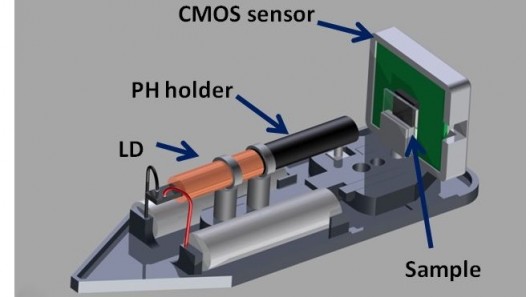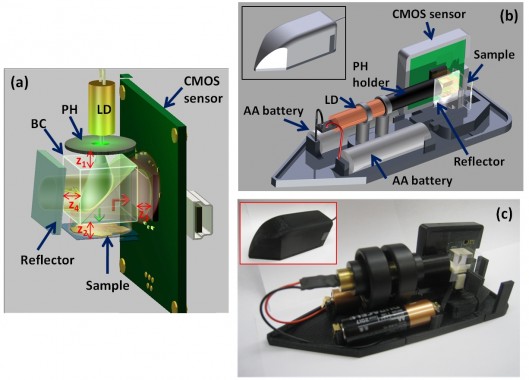
UCLA's low-cost, lightweight, rugged microscope utilizes holograms instead of lenses (Image: Ozcan BioPhotonics Group at UCLA/Biomedical Optics Express)
While financial contributions are certainly a great help to health care practitioners in developing nations, one of the things that they really need is rugged, portable, low-cost medical equipment that is compatible with an often-limited local infrastructure. Several such devices are currently under development, such as a battery-powered surgical lamp, a salad-spinner-based centrifuge, and a baby-warmer that utilizes wax. UCLA is now working on another appropriate technology in the form of a small, inexpensive microscope that uses holograms instead of lenses to image what can't be seen by the human eye.
Currently in the prototype stage, the microscope fits in the palm of the hand, and reportedly weighs "as much as a medium-sized banana." It is made entirely from off-the-shelf electronics, resulting in a total materials cost of just US$50 to $100 per unit. Although the microscope itself collects raw data, an external laptop, smartphone, or cloud-based system performs all the processing. Power is supplied by two stock AA batteries.
One of the device's most notable cost- and weight-cutting features, however, is the fact that it doesn't use lenses. Instead, it divides an inexpensive laser light source (such as that from a laser pointer) into two beams. One of those beams is directed to the sample being imaged, where it either passes through or deflects off of the cells or particles. The other beam, which serves as a reference, does not. Both beams end up at a smartphone-grade sensor chip, which analyzes the interference pattern that results when they meet. Once that data has been crunched, an image of what the first beam encountered can be produced.
Such images, obtained by causing light that has hit or passed through an object to interfere with a neutral "reference beam," are what are commonly known as holograms.
Besides being little, cheap and rugged, the microscope is also able to operate in two modes. In transmission mode it can image large volumes of liquid such as blood or water, while reflection mode is used for opaque materials. The spatial resolution for both modes is reportedly similar to that offered by low- to medium-power lenses.
Aydogan Ozcan, an associate professor of electrical engineering and bioengineering who is leading the research, is also in the process of forming a company to commercialize the technology. "Global health is a big field that requires better diagnostic tools, because resource-poor countries don't have the infrastructure for conducting essentially accurate diagnostic tests," he said. "There are so many problems that innovative solutions [like this microscope] would impact."
The UCLA research was recently published in the journal Biomedical Optics Express.
Copyright © gizmag 2003 - 2011 To subscribe or visit go to: http://www.gizmag.com
